Article elaborat pel Departament de Publicitat i Comunicacions de la Fundació Vila Casas, 2017.
Article prepared by the Publicity and Communications Department of the Fundació Vila Casas, 2017.
l’exposició
La Fundació Vila Casas presenta una mostra individual de l’artista Alberto García-Alvarez (Barcelona, 1928) després d’una Ilarga temporada sense exposar a la seva ciutat natal tot i haver desenvolupat una extensa trajectòria expositiva, tant als Estats Units com a Nova Zelanda.
L’exposició aplega una quinzena de peces: per una banda, pintures sobre paper de gran i petit format i, per l’altra, els “Crossings”, unes peces escultòriques amb base de fusta que, com el seu nom indica, es regeixen pels encreuaments. Complementant les obres, un compendi de material documental com llibretes, apunts o llibres, formen part d’aquest discurs expositiu situat a l’Espai Volart de la Fundació Vila Casas. A cura d’Anna Llopis, la mostra romandrà oberta fins al 28 de maig.
Exhibition
The Vila Casas Foundation presents an individual sample of the artist Alberto García-Alvarez (Barcelona, 1928) after a long period of time without exhibiting in his hometown despite having developed an extensive exhibition history, both in the United States as in New Zealand.
The exhibition brings together fifteen pieces: on the one hand, paintings on large and small format paper and, on the other, the “Crossings”, sculptural pieces with a wooden base which, as the name implies, are governed by crossings. Complementing the works, a compendium of documentary material such as books, notes or books, are part of this exposition speech located in the Espai Volart of the Vila Casas Foundation. Under the care of Anna Llopis, the exhibition will remain open until May 28.
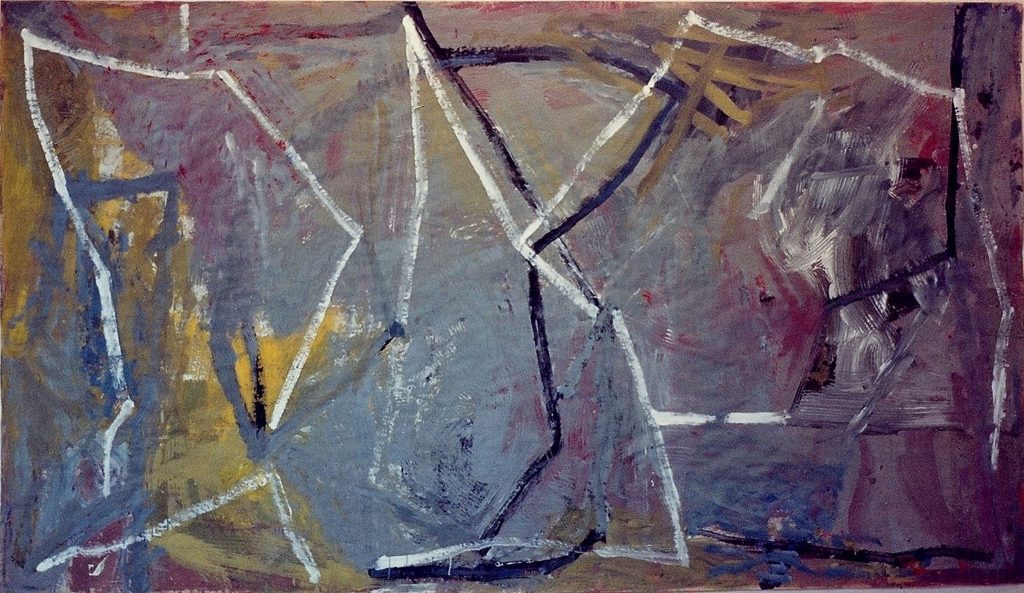
L’extraordinària quantitat i varietat d’obres que Alberto García-Alvarez ha dut a terme durant més de 60 anys es manifesta, aquí, de manera selectiva i reduida, centrant l’atenció en les dues tipologies abans citades i deixant-ne fora moltes d’altres com la pintura al fresc, el mosaic, el vitrall o el vidre pintat.
Garcia-Alvarez va formar part del grup Flamma (fundat l’any 1948 i dissolt l’any 1961) al costat dels aleshores estudiants de l’Escola Superior de Belles Arts de Sant Jordi de Barcelona Joan Lleó, Domènec Fita, Romà Vallès i Francesc Carulla. El grup va centrar la seva pràctica artistica en la pintura mural, tècnica que traspuarà, a partir d’aleshores, de les obres de García-Alvarez en el sentit més conceptual del terme. Segons Peter Vuletic, autor d’un dels textos que formen el catàleg, “normalment, el mètode emprat en la tècnica del fresc és preparar la base amb calç en petites àrees, al sostre o a les parets. Es dibuixa un esbós de l’obra proposada en fulls de paper més grans o més petits i, ràpidament, abans que la calç endureixi, el contorn de la imatge es transfereix sobre la calç encara humida. Aquesta metodologia juntament amb l’ús primerenc de grans fulls de paper i una execució ràpida, caracteritzen encara avui el treball d’Alberto García-Alvarez”.
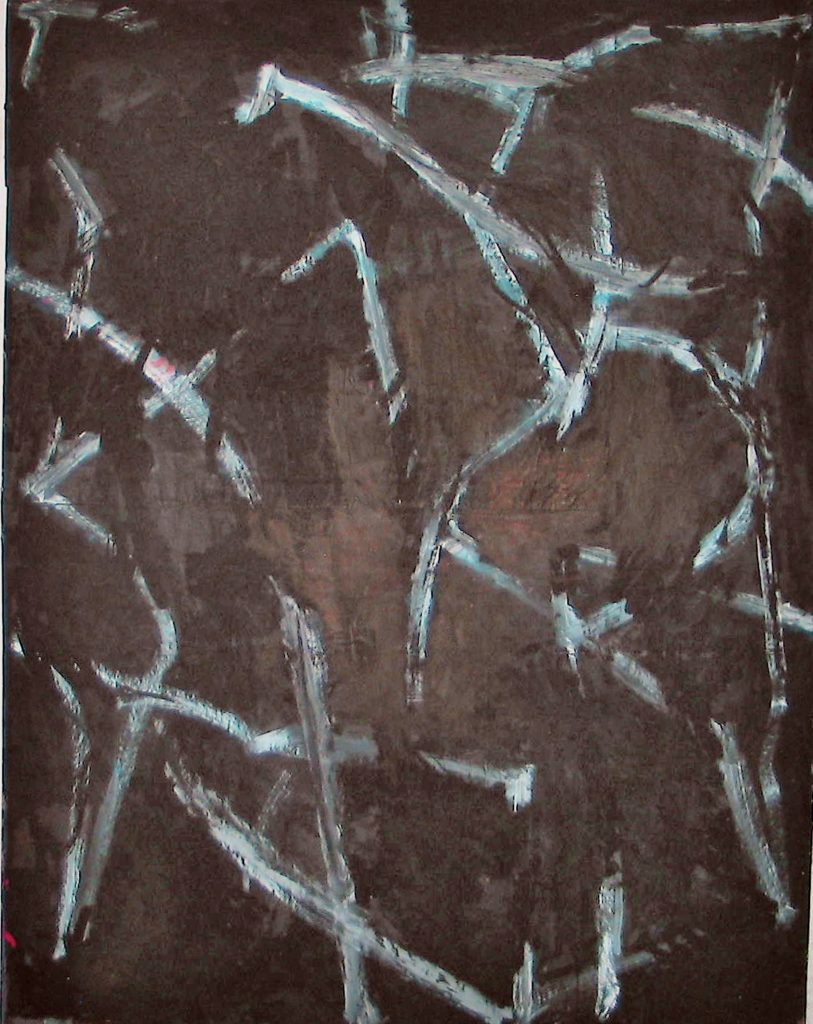
201.1990. Mixed media on paper. 213 x 168 cm .
La utilització del paper de gran format com a suport suposa un repte per a l’artista ja que si utilitza el gruix i el gramatge adequats, el paper adquireix una consistència ideal i una superfície suau, que ell prefereix davant de la tela o d’altres materials. Tot i que el mètode d’execució és ràpid, el procés i la reflexió es dilaten en el temps i les decisions formals es prenen a mesura que avança la feina. Afirma Peter Vuletic: “Després de la deguda deliberació, esporgant la ment d’idees preconcebudes, comença a pintar. Percep la feina a realitzar com una lluita contínua, com una batalla. A mesura que avança poden sorgir nous problemes, als quals s’haurà d’enfrontar. Resoldre’ls en pot generar també d’altres”.
Aixi doncs, la reflexió esdevé part indiscutible del mètode de treball d’Alberto García-Alvarez tot i que, a voltes, pot semblar que l’obra s’ha executat de manera espontània i sense raonament aparent.
Pel que fa als “Crossings”, es converteixen en el segon eix vertebrador de l’exposició. Obres sobre fusta, encreuaments, associacions religioses: tot això defineix aquesta sèrie que l’artista va començar l’any 1967 a Sausalito (Califòrnia). “En aquell moment eren muntatges de travessers de fusta que s’encreuaven els uns amb els altres, sense cap referència ni intenció específica que no fos la d’establir punt de tensió, de conflicte. Amb els anys, però, i de manera inconscient, es van anar introduint les a•lusions a la creu i al símbol”, explica Vuletic, i afegeix: “el que havia estat subliminal en les primeres creacions va esdevenir un element conscient o, si més no, un factor a tenir en consideració en les creacions posteriors”. Així, la mostra aplega un total de sis “Crossings” que, tot i diferenciar-se substancialment de les pintures sobre paper, mantenen unes similituds formals que ens ajuden a entendre l’artista des de dues òptiques clarament diferenciades però que beuen d’una mateixa font.
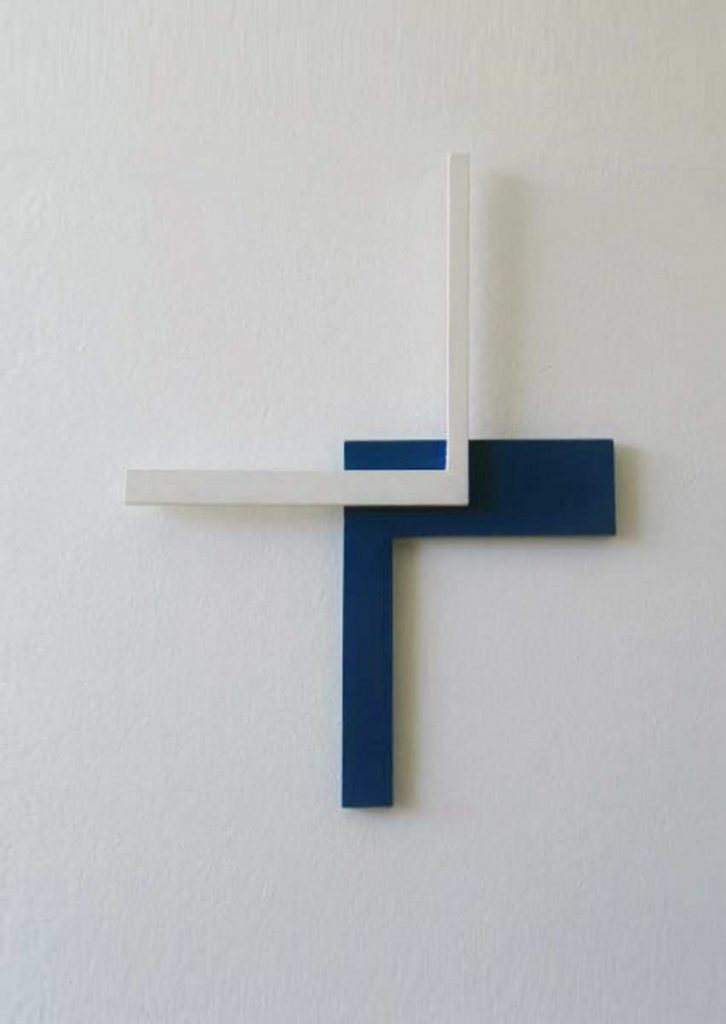
Crossings: 1998-8. 1998. Painted wood. 61 x 47 cm.
Per tal d’entendre amb profunditat l’obra d’Alberto García-Alvarez, no podem oblidar la seva vinculació amb el món de la docència. Ambdós espais professionals i també vitals, la docència i la trajectòria artística, han conviscut durant molts anys enriquint-se i sense estar mai renyits. Recordem que García-Mvarez arriba a la Facultat de Belles Arts d’Elam, primer com a professor visitant, i després per posar en marxa un departament de gravat i un programa de màsters. En aquest entorn universitari García-Alvarez es distingeix, ben aviat, com a intel.lectual, i l’estreta relació amb la universitat li permet pintar amb total llibertat, sense fixar, mai, la mirada cap al mercat de l’art. “Havies de trobar altres formes de mantenir-te, com per exemple ensenyar, per continuar la pràctica”, afirma l’artista en unes declaracions subratllant la relativa importància que té, per ell, vendre la seva obra.
Aquesta llibertat, doncs, traspua en les seves obres sinceres i despreocupades. “La seva obra està lliure d’artifici. E1 seu és un art sense pretensions, que es complau de l’acte físic de pintura i exposa el seu sentit únic del color”, afirma Peter Vuletic, i afegeix: “[en les seves obres] hi ha confrontació sense intimidar. No vacil.len, no són tímides ni insegures. Revelen una manera única d’utilitzar el color / pigment / paleta, especialment quan barreja els seus propis pigments i colors”. Aquesta manera de treballar a partir de la preparació dels seus propis colors amb pigments ens remet, una vegada més, a la seva vinculació amb la pintura mural i amb el grup Flamma. L’aspecte de les seves pintures és sec, quasi deshidratat, com l’aparença, gens brillant, de les pintures medievals.
“La seva obra, de vegades molt austera o fins i tot crua, té però una discreta bellesa lírica, on cada peça té el seu propi estat d’ànim i la seva presència reflexiva”, conclou Petar Vuletic.
The extraordinary quantity and variety of works that Alberto García-Alvarez has carried out for more than 60 years is shown here, in a selective and reduced way, focusing on the two types mentioned above and leaving out many others like fresh paint, mosaic, stained glass or painted glass.
García-Alvarez was part of the Flamma group (founded in 1948 and dissolved in 1961) along with then students of the School of Fine Arts of Sant Jordi of Barcelona Joan Lleó, Domènec Fita, Romà Vallès i Francesc Carulla. The group focused its artistic practice on mural painting, a technique that took its place, as of that time, in García-Álvarez’s works in the most conceptual sense of the term. According to Peter Vuletic, author of one of the texts that make up the catalog, “normally, the method used in the technique of the fresco is to prepare the base with lime in small areas, on the ceiling or on the walls. An outline of the work proposed is drawn in larger or smaller paper sheets, and quickly, before the lime hardens, the outline of the image is transferred over the still moist lime. This methodology, along with the early use of large sheets of paper and a fast execution , still characterize the work of Alberto García-Alvarez. “
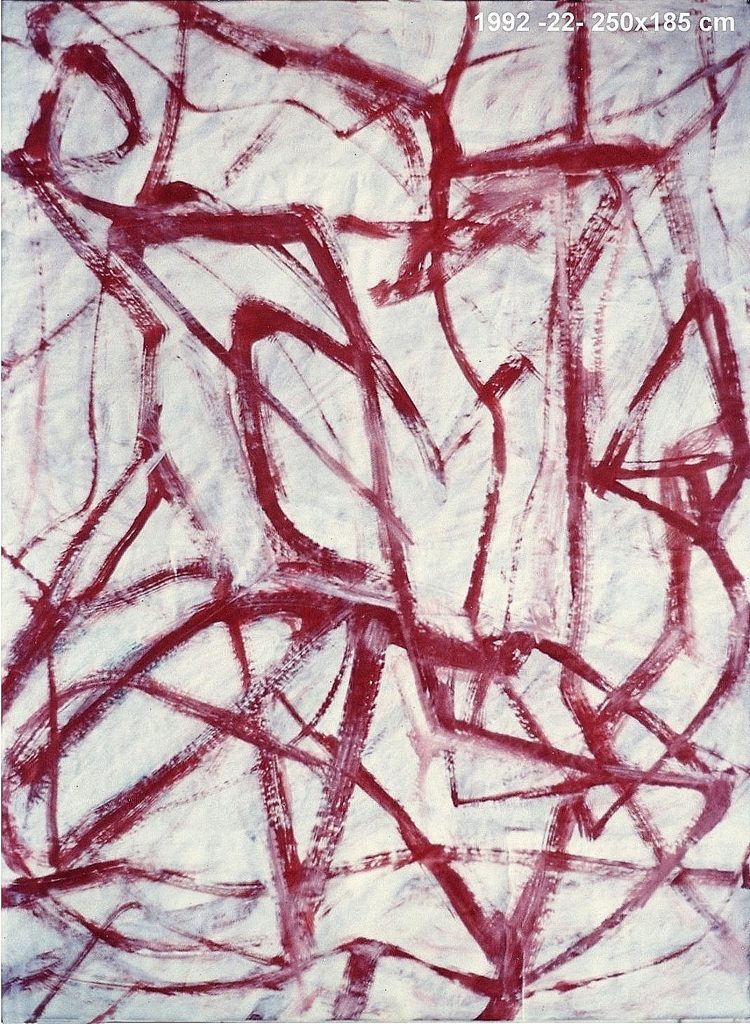
22.1992. Mixed media on paper. 250 x 185 cm .
The use of large format paper as a support poses a challenge for the artist, since if he uses the right thickness and weight, the paper acquires an ideal consistency and a soft surface, which he prefers to canvas or other materials Although the method of execution is fast, the process and reflection are dilated in time and formal decisions are made as work progresses. Peter Vuletic says: “After deliberation, exploring the mind of preconceived ideas, he begins to paint. He perceives the work to be done as a continuous struggle, as a battle. As it progresses, new problems may arise which he will have to face. Resolving them can also generate others. ”
Therefore, reflection becomes an indisputable part of Alberto García-Alvarez’s method of work, although it may seem that the work has been performed spontaneously and without apparent reasoning.
As for the “Crossings”, they become the second axis of the exhibition. Works on wood, crossroads, religious associations: all this defines this series that the artist began in 1967 in Sausalito (California). “At that time they were assemblies of wooden frames that crossed each other, with no reference or specific intention other than to establish a point of tension, of conflict. Over the years, however, and unconsciously , the references to the cross and to the symbol were introduced, “explains Vuletic, adding:” What was subliminal in the first creations became a conscious element or, at least, a factor to be taken into account in subsequent creations “. Thus, the exhibition brings together a total of six “Crossings” that, although differentiated substantially from the paintings on paper, maintain formal similarities that help us to understand the artist from two clearly differentiated perspectives yet integrating to one same source.
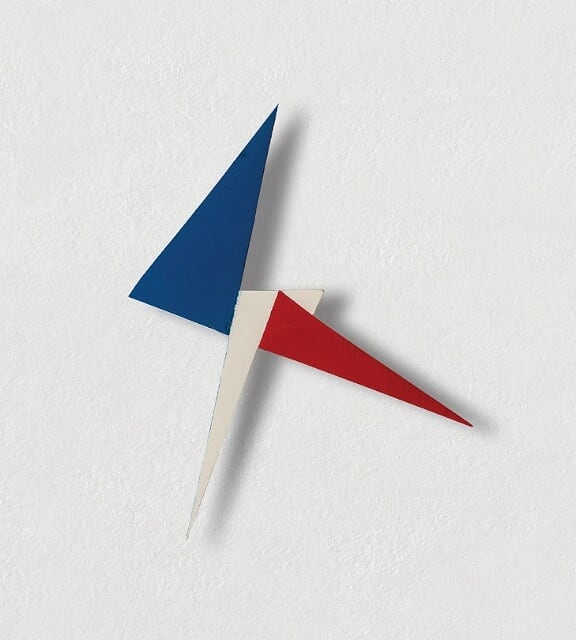
Crossings: 2004-87. 2004. Painted wood. 56 x 48 cm.
In order to understand in depth the work of Alberto García-Alvarez, we can not forget its connection with the world of teaching. Both professional and living spaces, teaching and artistic career, have coexisted for many years without being ever-enriched. Recall that García-Mvarez arrived at the Faculty of Fine Arts of Elam, first as a visiting professor, and then to start a print making department and a master’s degree program. In this university environment García-Alvarez was immediately distinguished as an intellectual, and the close relationship with the university allowed him to paint with total freedom, without ever fixing his gaze towards the art market. “You had to find other ways to keep yourself, such as teaching, to continue the practice,” the artist comments in a statement emphasizing the relative importance of selling his work for him.
This freedom, then, transcends his sincere and carefree works. “His work is free of artifice. His is an art without pretensions, who is pleased with the physical act of painting and exposes his unique sense of color,” says Peter Vuletic, adding: “[in his works] there is confrontation without intimidation. Do not hesitate, they are neither shy nor insecure. They reveal a unique way to use the color / pigment / palette, especially when mixing their own pigments and colors. ” This way of working from the preparation of their own pigmented colors leads us, again, to their connection with the mural painting and the Flamma group. The appearance of his paintings is dry, almost dehydrated, as the appearance, not at all brilliant, of medieval paintings.
“His work, sometimes very austere or even raw, has a discreet lyrical beauty, where each piece has its own state of mind and its reflective presence,” concludes Petar Vuletic.
Pingback: “Visiones y desconciertos”: Espais Volart, Barcelona – Fundació Vila Casas; 6 April – 28 May 2017 – Alberto Garcia-Alvarez